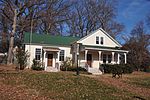Four Stairs

Four Stairs is a historic home located at Great Falls, Fairfax County, Virginia. The earliest section was built about 1737, as a gable-roofed, one-room, one-story with loft log house. It was later enlarged with a shed-roofed west side log pen and rear shed-roofed timber-framed kitchen. These early sections were raised to two-stories after 1796. A two-story, three-bay, parlor-and-side-hall-plan frame addition in the Greek Revival style was built about 1850, and became the focus of the house. The house was restored in 2002–2004. Also on the property are a contributing a family cemetery and a stone-lined hand-dug well.It was listed on the National Register of Historic Places in 2004.
Excerpt from the Wikipedia article Four Stairs (License: CC BY-SA 3.0, Authors, Images).Four Stairs
Leigh Mill Road,
Geographical coordinates (GPS) Address Nearby Places Show on map
Geographical coordinates (GPS)
| Latitude | Longitude |
|---|---|
| N 38.986111111111 ° | E -77.276388888889 ° |
Address
Leigh Mill Road
Leigh Mill Road
22066
Virginia, United States
Open on Google Maps










